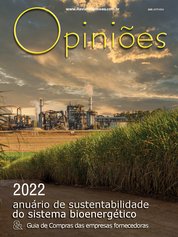Raphaella Gomes
CEO of Raizen Biogas
AsAA22
The energy and the progress
Since the dawn of humanity, energy and progress have been intrinsically intertwined. Each evolutionary leap was based on a new source of energy, from the discovery of fire 400,000 years ago, through the agricultural revolution 10,000 years ago, with the mastery of animal motive power and the energy of water and wind, to the use of of fossil fuels in the Industrial Revolution in the late 19th century.
Throughout our civilizational journey, access to an affordable, efficient and reliable source of energy has supported increasing population growth, technological development and has even allowed humanity to venture into space exploration. Unfortunately, this progress has not come without cost. Today, we understand that burning large amounts of fossil fuels has increased the amount of carbon dioxide in the air at levels the planet can no longer balance.
Recognizing the impact of this situation, the world came together to face the problem, and in 2015, the Paris Agreement was signed. In it, countries committed to keeping global warming below 2 degrees centigrade, achieving carbon neutrality by 2050. At COP26 held in 2021, countries agreed to go beyond the agreement, limiting global warming to 1.5 degrees centigrade.
To achieve these goals, the world needs to face three enormous challenges: (1) clean up the energy matrix; (2) ensure that (growing) energy needs are met by renewable sources; (3) not destabilizing power supply and base power, ensuring fair access to energy for all. These are not easy tasks. For a fossil fuel-based society, this means changing the essence of how we do things. From energy production, transmission and distribution, to economic systems and habits and consumption, everything will need to be adapted if we are to embrace the path to this new reality.
In Brazil, according to data from the 2020 Energy Research Company, the energy matrix is almost 50% renewable, with the electrical matrix being 83% renewable, with a large share of hydro (more than 65%), biomass thermal and wind and solar energy (similar to 10% and 6%, respectively). Compared to the world energy matrix, which has only 14% from renewable sources, Brazil is already a reference. Solar and wind, despite their competitive cost, are intermittent, non-dispatchable sources, that is, when there is no sun or wind, there is no generation of electricity. Therefore, they need to be complemented by other renewable sources or storage solutions.
Biomass is a great complement to intermittent sources. Thermal energy from the burning of biomass is already used in the United Kingdom, the Netherlands, Germany and Japan. In Brazil, the generation of electricity from biomass represents almost 10% of the electricity matrix and, according to the Union of the Sugar Cane and Bioenergy Industry, in the first half of 2020 alone, the emission of 2.8 millimeters of tons was avoided. of carbon dioxide, equivalent to 20 million trees for 20 years.
Agricultural residues can also be used to produce biogas, a biofuel generated from the biodigestion of organic matter. According to data from the Brazilian Biogas Association, Brazil has a biogas production potential of approximately 120 millimeters per cubic meter per day, comparable to the supply of pre-salt gas, which led the biofuel to be called “Pre-salt” bumpkin. Biogas can be used for various applications, such as generating electricity or as renewable methane to replace fossil fuels, such as natural gas, Liquefied Petroleum Gas, diesel, fuel oil (with emission reductions of up to 95%). or even as an input for the production of hydrogen, green ammonia and biomethanol.
Brazil is also one of the largest producers of ethanol, with a production of approximately 30 billion liters per year, and has the largest fleet of flex fuel vehicles (approximately 80%) in the world. When compared to gasoline, ethanol reduces more than 80% of carbon dioxide emissions. The reality is that there is no single, right answer to the energy transition, and whatever the path, there is only one certainty: that we need to go faster. In Brazil, we already have numerous examples of abundant and efficient renewable energy, which, in addition to decarbonizing our energy matrix, can support the world towards the next revolution.




